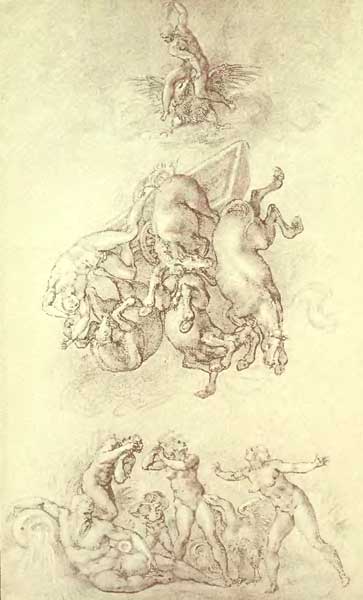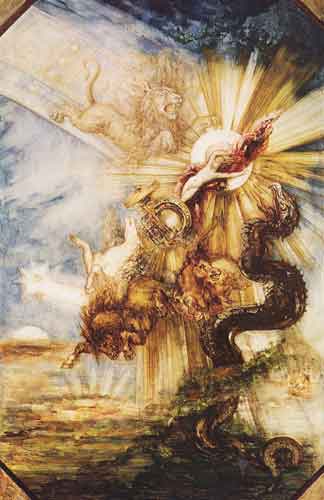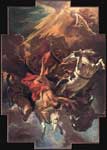
Phaethon, study of Michelangelo, drawing made for Tommaso Cavalieri. Royal Collection at Windsor Castle
In Greek mythology, Phaëton or Phaethon ("shining"), was the son of Helios (Phoebus, the "shining one", an epithet later assumed by Apollo), or of Clymenus by Merope or Clymene.
Alternatively, Eos bore Cephalus a son, named Phaëthon but Aphrodite stole him away while he was no more than a child, to be the night-watchman at her most sacred shrines. The Cretans called him Adymus, by which they meant the morning and evening star (Hesiod, Theogony, 986; Solinus, xi:9; Nonnus, Dionysiaca, xi:131 and xii:217).
Phaeton bragged to his friends that his father was the sun-god. His friends refused to believe him and so Phaeton went to his father Helios, who promised him anything he should ask for. Phaeton wanted to drive his chariot (the sun) for a day. Though Helios tried to talk him out of it, Phaeton was adamant. When the day came, Phaeton panicked and lost control of the white horses that drew the chariot. First it veered too high, so that the earth grew chill. Then it dipped too close, and the vegetation dried and burned. He accidentally turned most of Africa into desert; burning the skin of the Ethiopians black. Eventually, Zeus was forced to intervene by striking the runaway chariot with a lightning bolt to stop it, and Phaëthon plunged into the river Eridanus (the Po). His friend, Cycnus, grieved so, that the gods turned him into a swan. His sisters, the Heliades, also grieved and were turned into alder trees, or poplars according to Virgil; their tears became amber.

The fall of Phaeton, Johann Liss, beginning of 17th century.
The moral of the tale is a later addition. In earlier, Homeric references, (Iliad xi:735; Odyssey v:479) Phaëthon is simply another name for Helios himself. The substitution of Apollo for Helios as sun god occurred later than this legend.
Fragments of Euripides' tragedy on this subject, Phaethon survive. in reconstructing the lost play and discussing the fragments, James Diggle has discussed the treatment of the Phaeton myth (Diggle 2004).
The Fall of Phaeton, Peter Paul Rubens
The Fall of Phaeton, Jan Carel van Eyck

Fall of Phaeton, Peter Paul Rubens
The motif of the fallen star must have been familiar in Israel, for Isaiah referred to it in admonishing the king of Babylon for his pride (Isaiah 14:12ff). The Jewish Encyclopedia reports that "it is obvious that the prophet in attributing to the Babylonian king boastful pride, followed by a fall, borrowed the idea from a popular legend connected with the morning star". The falling star image reappears in John's Apocalypse without a name. In the 4th century Jerome's translation of the "morning star" as "Lucifer" carried the fallen star myth-element into Christian mythology. For fuller details, see Lucifer.
The story is the basis for a symphonic poem by Camille Saint-Saëns.
--------------------------------------------------------------------------------
For people and things named after the mythological figure, see Phaeton.

Phaeton, Gustave Moreau , 1878, Louvre, France
Nicolas Poussin. Helios and Phaeton with Saturn and the Four Seasons. c. 1629-30. Gemäldegalerie, Berlin, Germany
References
The Greek Myths: The Complete And Definitive Edition, Robert Graves
Diggle, James, 2004. Euripides: Phaethon (http://www.cambridge.org/uk/catalogue/catalogue.asp?isbn=0521604249) in series Cambridge Classical Texts and Commentaries (no. 12)
The Fall of Phaeton, Hans Rottenhammer
The Gods Mouning Phaeton, Theodoor van Thulden
The Fall of Phaeton, Joseph Heintz the Elder

Fall of Phaeton, Sebastiano Ricci

The Fall of Phaeton , Simone Mosca

The Fall Of Phaeton, James Ward
Links
George Stubbs's 'The Fall of Phaeton' (http://www.liverpoolmuseums.org.uk/picture-of-month/displaypicture.asp?venue=7&id=109) at the Lady Lever Art Gallery (http://www.liverpoolmuseums.org.uk/ladylever/index.asp)
See also : Greek Mythology. Paintings, Drawings
Retrieved from "http://en.wikipedia.org/"
All text is available under the terms of the GNU Free Documentation License
| Ancient Greece
Science, Technology , Medicine , Warfare, , Biographies , Life , Cities/Places/Maps , Arts , Literature , Philosophy ,Olympics, Mythology , History , Images Medieval Greece / Byzantine Empire Science, Technology, Arts, , Warfare , Literature, Biographies, Icons, History Modern Greece Cities, Islands, Regions, Fauna/Flora ,Biographies , History , Warfare, Science/Technology, Literature, Music , Arts , Film/Actors , Sport , Fashion --- |






